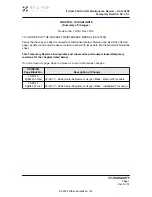
ARROW
C. G. RANGE AND WEIGHT INSTRUCTIONS
1.
Add the weight of all items to be loaded to the licensed empty weight.
2.
Use the loading graph to determine the moment of all items to be carried in the airplane.
3. Add the moment of all items to be loaded to the licensed empty weight moment.
4. Divide the total moment by the total weight to detennine the C.G. location.
5.
By using the figures of Item 1 and Item 4, locate a point on the C.G. range and weight
graph. If the point falls within the C.G. envelope, the loading meets the weight and balance
requirements.
SAMPLE LOADING PROBLEM (Normal Category}
Ann Aft
Weight
Datum
Moment
(Lbs)
(Inches)
(In-Lbs)
I
, 1
-
I:, SOI I
Licensed Empty Weight
�/}/
k�.A/
Atr$'J;
PYi32,559
t/'
Oil (8 quarts)
1
5
24.5
,
368
Pilot and Front Passenger
340
80.5
27370
.
Passengers, Aft (Rear Seat)
340
118.1
40154
Fuel (50 Gal. Maximum)
\
300
95.0
28500
�Baggage
83.2
142.8
11881
Moment due to Retracting of
Landing Gear
819
Total Loaded Airplane
2650.0
91.2
241651
·
The center of gravity (C.G.) of
this
sample loading problem is at
91 · 2
inches aft of the
datum line. Locate this point (
91. 2 )
on the C.G. range and weight graph. Since
this
point
falls within the weight-C.G. envelope, this loading meets the weight and balance requirements.
IT IS THE RESPONSIBILITY OF THE PILOT AND AIRCRAFT OWNER TO INSURE
THAT THE AIRPLANE TS LOADED PROPERLY.
*Check Aft C.G. between 150 lbs and 200 lbs.
'fooRT,
VB-334 PAGE 5-ll
/
ODEL: PA-28R-200
ISSUED: October
14, 1971
CJ.
N16422 POH







































